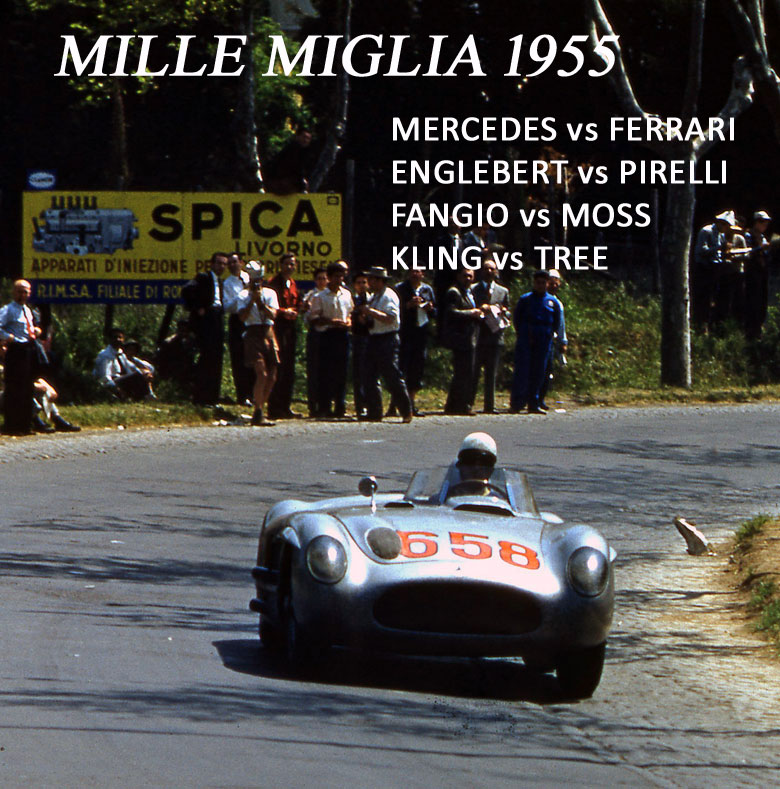
Fangio on the Mille Miglia. Note the Spica injection. Photo by John Bradshaw courtesy of Dale LaFollette.
Story by Pete Vack
Part 1 addressed the two main teams that participated in the 1955 Mille Miglia, Mercedes-Benz and Ferrari. No one else was even in the game for overall victory and with at least four entries each, one of the two was going to win the event.
Before we proceed, last week we noted that there were many 300SL Gullwings that were used for practice weeks before the event itself, which would be a victory for the Germans in all classes, including our own late John Fitch, who placed 5th overall with a Gullwing and won his class, a remarkable achievement.
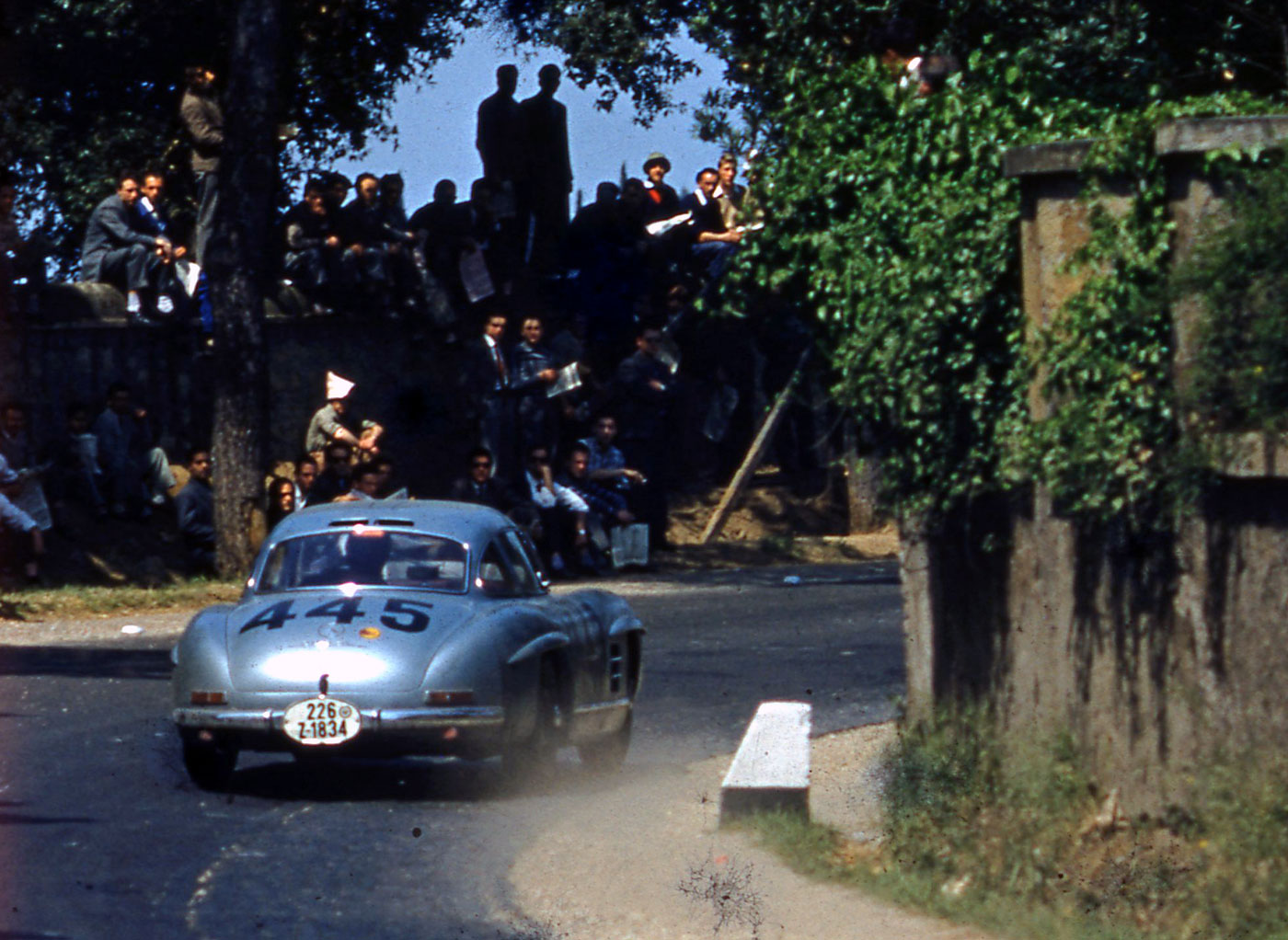
We found this rather beautiful shot of an unidentified 300SL during the 1955 Mille Miglia. It is not Fitch, for he was number 417. Readers? Photo by John Bradshaw courtesy of Dale LaFollette.
Englebert vs Pirelli
We see that in 1931 the Mercedes won rather easily as the Alfas had tire problems. In 1952, Kling surged ahead of Bracco as the Ferrari driver had tire problems, while Taruffi had drivetrain problems. If this kind of failure seems illogically repetitive, it is. Before the 1955 Mille Miglia several of his drivers including the Marzotto brother begged or coerced Ferrari into replacing the Belgian Engleberts with something better, and something betters was Pirelli and that proved not to be good enough. In a story about Mike Sparken (in VT of course) Graham Gauld wrote about why Ferrari had contracted with Engelbert:
The reason for Ferrari running on these relatively unknown Belgian tyres was that some time earlier Enzo Ferrari was piqued at Pirelli for not letting him have Pirelli Corsas as Pirelli had a contract with Alfa Romeo. As a result, he signed up with Englebert to race on these tires and they were certainly not the best at that time. I recall talking at a race with the meek, mild and aged competitions manager of Englebert, Maurice Ledard, and the poor man was having a terrible time with Ferrari and their tyres.
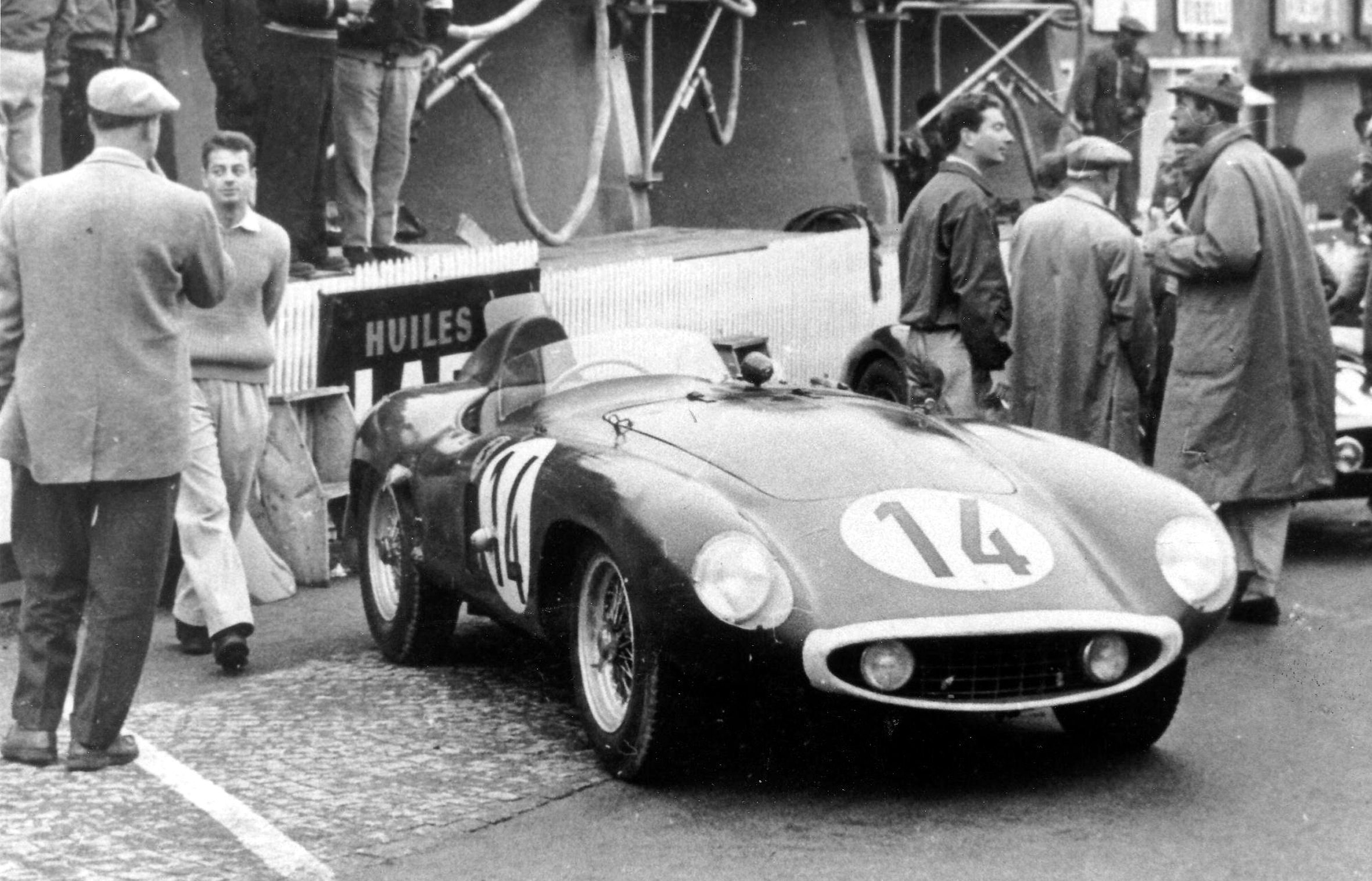
Sparken’s Ferrari Monza at the pits, Le Mans 1955. Sparken is on the right talking to Harry Schell in the raincoat.
Ironically, the Pirellis didn’t hold much air either…two of the four Ferraris, Castellotti and Marzotto had tire problems. As Sparken related to Gauld, “In those days tyres were a real problem on the sports cars with bodies which didn’t allow much air into the wheels and we were in a very hot country with a very hot road. What we did was put in so much pressure you had a fifty-fifty chance of having a tread come off. My friend Jean Lucas had done a deal with the French tyre company Kleber Colombes – who had bought his Monza for him – and they were even worse.”
For 1957, Ferrari was back on Engleberts with tragic results as Portago went off the road killing himself and 11 others ending the Mille Miglia. Both Ferrari and Englebert were cleared of any charges by 1961 (since none of the other Ferraris shod with Engleberts had tire trouble during the 1957 event) but the damage was done. In another twist of fate, in 1958 Englebert was bought by Uniroyal, and in 1979 Uniroyal sold its European tire businesses, including Englebert, to Continental, the tire company that shod the winning Mercedes-Benz in the 1955 Mille Miglia.
Juan Fangio vs Stirling Moss
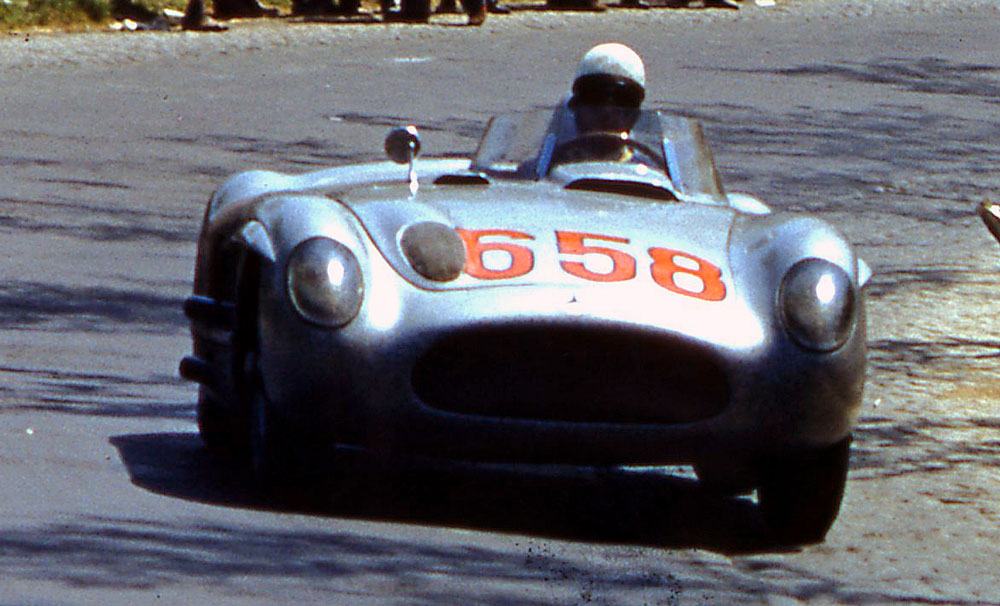
Fangio alone in the 300SLR at the Mille Miglia. He is wearing a borrowed white helmet. Photo by John Bradshaw courtesy Dale LaFollette.
There has been much conjecture about whether or not Fangio was not as good as Moss driving sports racers. Given Fangio’s record that is questionable: In 1955 alone with Mercedes-Benz, after the Mille Miglia he won the Eifelrennen at the Ring, Kristianstadt in Sweden and finished second to Moss at the TT and Targa Florio. But Fangio did not particularly like the Mille Miglia. “To try to run a 1000 mile race in ten hours was madness….During the race normal traffic was not totally blocked off , although people kept away. Still, at the start of one of the Mille Miglia races, I almost hit a car coming the other way.” Fangio never won the Mille Miglia although he would have liked to, and very nearly did with Alfa in 1953 before a broken tie rod end allowed a front wheel to wander.
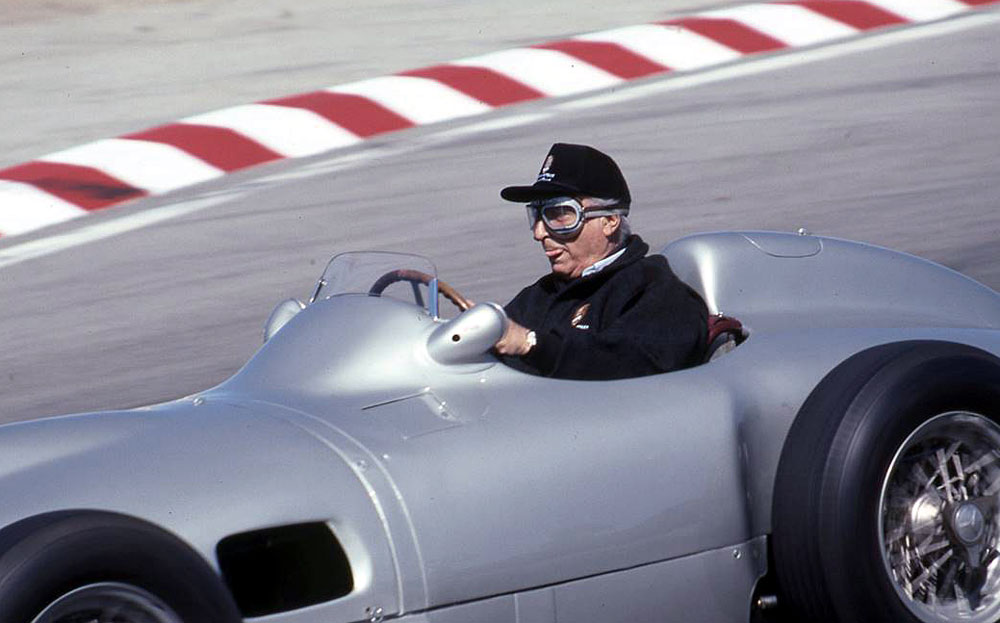
Fangio at Laguna driving the W196, perhaps recalling his Mille Miglia drive with Mercedes. Dale LaFollette photo.
Everyone is familiar with the dark brown helmet worn by Fangio, but in the 1955 Mille Miglia he was wearing a white helmet. “It was borrowed. Someone gave it to me before the start. Perhaps I had forgotten my own?” He didn’t quite recall. He did recall what happened to his engine during the race. “A fuel injection line broke and the engine was running on seven cylinders for nearly half the race.” Even Hans Herrmann, complete with a navigator, caught up and passed the ailing Fangio 300SLR. He found it frustrating when he found his car down on power but the mechanics kept saying, no, all is ok and kept him on the road. He finally insisted that the take a look. The broken line was replaced but they didn’t replace the plugs, so the fix did Fangio no good and there was no time left to catch the flying Moss. Still he finished second and ahead of the 118/121 LM of Umberto Maglioli.
Hans Herrmann
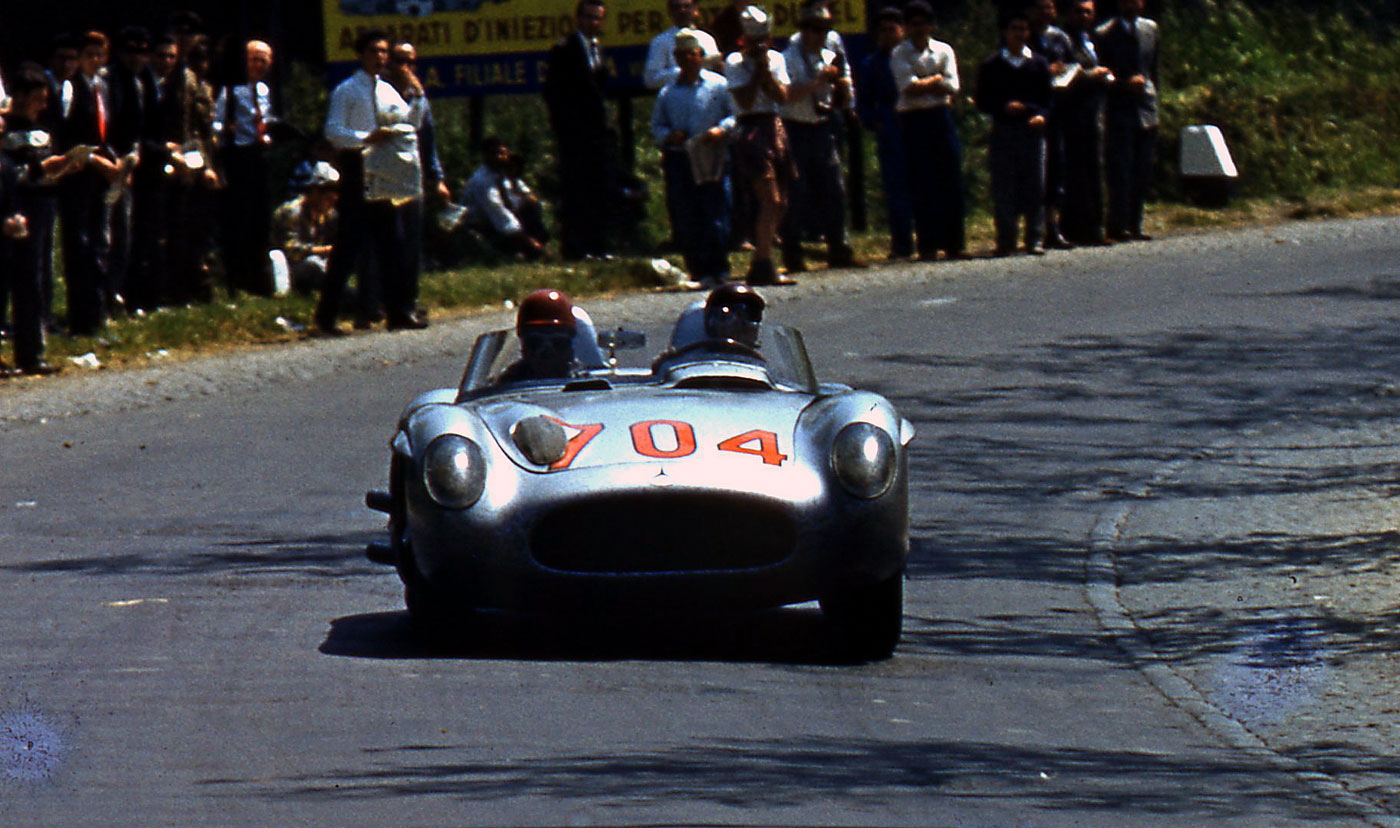
Hans Herrmann and Hermann Eger at speed before the gas cap came loose. Photo by John Bradshaw courtesy Dale LaFollette.
As recounted by Graham Gauld and Hans Herrmann for VeloceToday, September 24, 2017:
For the 1955 Mille Miglia Hans Herrmann took Fangio’s mechanic Hermann Eger with him. In the race Hans caught up and passed Fangio, who had started six minutes ahead of him, and set out for Moss. By Rome Hans was lying third behind Piero Taruffi’s mighty Ferrari and Moss but had had trouble with his throttle. When Taruffi retired it was Moss versus Herrmann but then came disaster. At the Rome fuel stop the full filler cap was not put back fully and it came off on the Futa Pass and drenched Hans and Hermann Eiger in fuel. Some got in Hans’ eye and he spun off the road and hit a bank. They both leaped out of the car assuming it would burst into flames and then walked to a nearby village to change out of their overalls and into some borrowed pajamas.”
Karl Kling
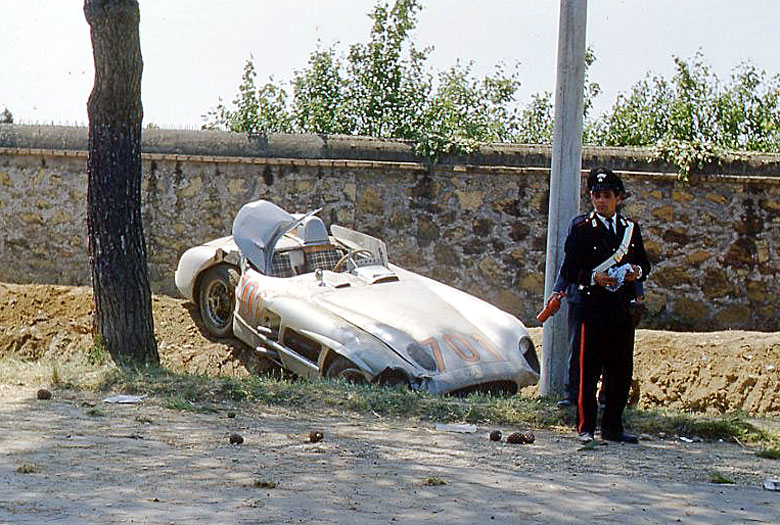
Kling’s 1955 Mille Miglia was shortened by an off into a rather unyielding tree right outside of Rome, captured here by American photographer John Bradshaw courtesy Dale LaFollette.
Karl Kling had a good season, even though he might not have thought so. He partnered with Fangio for the two wins in Germany and Sweden, and supported Moss and Fangio in the Grand Prix races. But Fangio wrote of 1954 and 55 season, “My teammates were the Germans Karl Kling, Herman Lang and the young Hans Herrmann. I won, and won, and won. It does not please everyone when you win all the time. What’s more, the German drivers weren’t winning…the fact is that the German drivers had not proved very fast. Except Karl Kling, that is, who had an extraordinarily high opinion of himself. This ‘amour propre’ (self esteem) was perhaps not as great as his patriotism. What he wanted was an all-German victory at any cost!”
Piero Taruffi
Veteran driver and engineer Piero Taruffi drove for both Mercedes in GP cars and Ferrari in sports in 1955. After having won the Giro d Sicilia with the new Ferrrari 3700 cc six, Taruffi was hopeful for the Mille Miglia. Paolo Marzotto initially led the race until a tire blew at 160 mph, and it was then up to Castellotti to chase and overtake Moss, but consecutive tire problems and eventually a blown engine doomed his effort. Then it was Taruffi’s turn, and he was neck and neck with Moss until Rome. Then 20 miles past Viterbo the transmission went out leaving Moss to win at 97.4 mph for the 1000 miles with Fangio second and Maglioli in the fourth 118/121 in third.
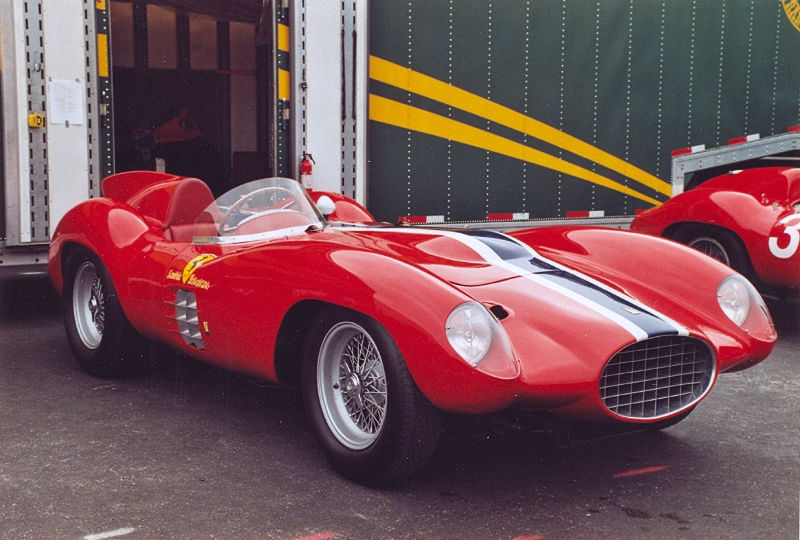
Taruffi’s mount in the 1955 Mille Miglia, S/N 0484 LM. In August of 1955 it was rebodied and sold to Tony Parravano. Hugues Vanhoolandt photo.
A few months later at the British Grand Prix, Taruffi was tapped to drive for Mercedes. Moss won, Fangio was second, Kling third and Taruffi in fourth made it a total Benz victory. Page 141 Taruffi. At the Italian GP, Moss and Kling retired leaving Taruffi to finish second to Fangio in the streamliner. “After the race I gathered that Kling had been very upset at being overtaken, even though there had been no ‘stay put’ signal from the pits. He took no account of this and treat me to a long and excited remonstrances in German.”
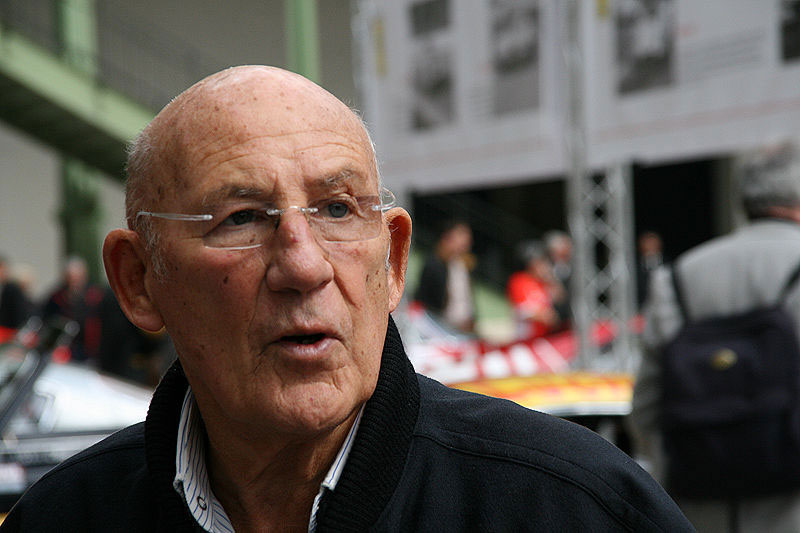
Moss paid tribute to Kling though, saying that the German would have shown up much better if Fangio had not been on the team. “He was winning races at the age of 17 and at 43 romped home in the tough Panamericana with a record time.” Hugues Vanhoolandt photo.
So why didn’t Ferrari tell anyone that the 118s were really 121LMs?
Umberto Maglioli, who finished third behind Fangio, summed it all up when interviewed for a chapter in the must-have book, “The Red Arrows.” And we quote:
“Officially, my car was a 3750cc Type 118 LM. In reality, it was a four and half liter 121 LM, but Ferrari did not want anyone to know. He was sure he would lose the race; but to him it seemed more dignified if his 3750s rather than his four and a half liters were beaten by the three liter Mercedes. After the race, I was told by Ferrari’s chief construction mechanic, Attilio Galetto, who heard me talk about the 3750. ‘Don’t talk nonsense. You all had four and a half liter engines.’”
A fascinating bit of Enzoism.
Sources
Stirling Moss Book of Motorsport, Cassell and Co. London, 1955
Works Driver, Taruffi, Temple Press 1964
Fangio, My Racing Life, Carozzo, Fangio, Patrick Stevens Ltd 1986
Red Arrows, Marzotto, Nada, 2001
Mille Miglia 1927-1957, Lurani, Automobile Year, 1981
Mille Miglia Race, the Postwar Years, Curami, Nada, 1998
Based on Janos Wimpffen’s book Time and Two Seats, the #445 300SL was raced by Salvatore Casella, who finished 10th overall.
Willem is correct according to official stats. He aslo came 3rd in the GT+1.3 class. The number plate suggests the car was picked up new at the factory under the Mercedes-Benz home delivery programme.
I agree that Casella was driving the 300 SL, I was in a hurry when I sent Pete the photos and neglected to give him this information. Time and Two Seats is a great reference for the late years of the Mille Miglia but (for those who care) there is an Italian book that has the entry of all the Mille Miglia Races from 1927 to 1957. It is MILLE MIGLIA by Giovanni Canestrini and while it is all in Italian it is the only single source that I have found for the complete listing.
And I have a copy of TATS as well but failed to check there! Thanks to you both for helping with the identification!
Ed.
There a more complete and reliable book listing every entrant in the Mille Miglias from 1927 to 1957. The authors are two of the top Italian motor historians: Angelo Tito Anselmi and Valerio Moretti. Angela Cherrett and Simon Moore contributed. It was published in a numbered edition (I have no. 544) by: Le Edizioni dell’Opificio, which was the publishing trademark of the late Anselmi. Text is Italian and English. Graphic quality is at top, like every job by Anselmi.
When new (2003) the price was 35.00 euro.
Of every competitor are mentioned: First and last name, car make and model, racing number, start time, time to cover the Brescia-Roma leg, total time, overall final result.
About Englebert tyres. Ferrari has been an Englebert client since the early times of the Scuderia. At the 1932 Spa 24 Hours the Alfa Romeos of the Scuderia were shod with Englebert tyres. The Belgian company was already powerful and rich enough to have a giant ad on the track bypass. A famous photo is on page 167 of “La Scuderia Ferrari 1929-1939” by Orsini and Zagari, Editoriale Olimpia, Florence 1979.
Another proof of the long-established Ferrari-Englebert links is the photo (1930?) of Ferrari and Nuvolari posing with the Englebert brothers in front of one of the Scuderia vans. The photo is published on page 25 of my book: “Piloti dell’altro mondo”, AISA-Associazione Italiana per la Storia dell’Automobile, Milano 2016.
There are literally dozens of books on the Mille Miglia but the one that surpasses all the others is “Mille Miglia Una Corsa Italiana” by Luigi Orsini,published by Abiemme.
This 358 page masterpiece gives all the entrants,race numbers,section results and everything you’ll ever need to know.The pictures too are among the best and reproduction is decent.The book is not easy to find (check Italian ebay) and will set you back at least 200 to 250 euros.Obviously it is in Italian only but as I have been advocating all my life : LEARN LANGUAGES!
Keep up the good work,
Michel Van Peel